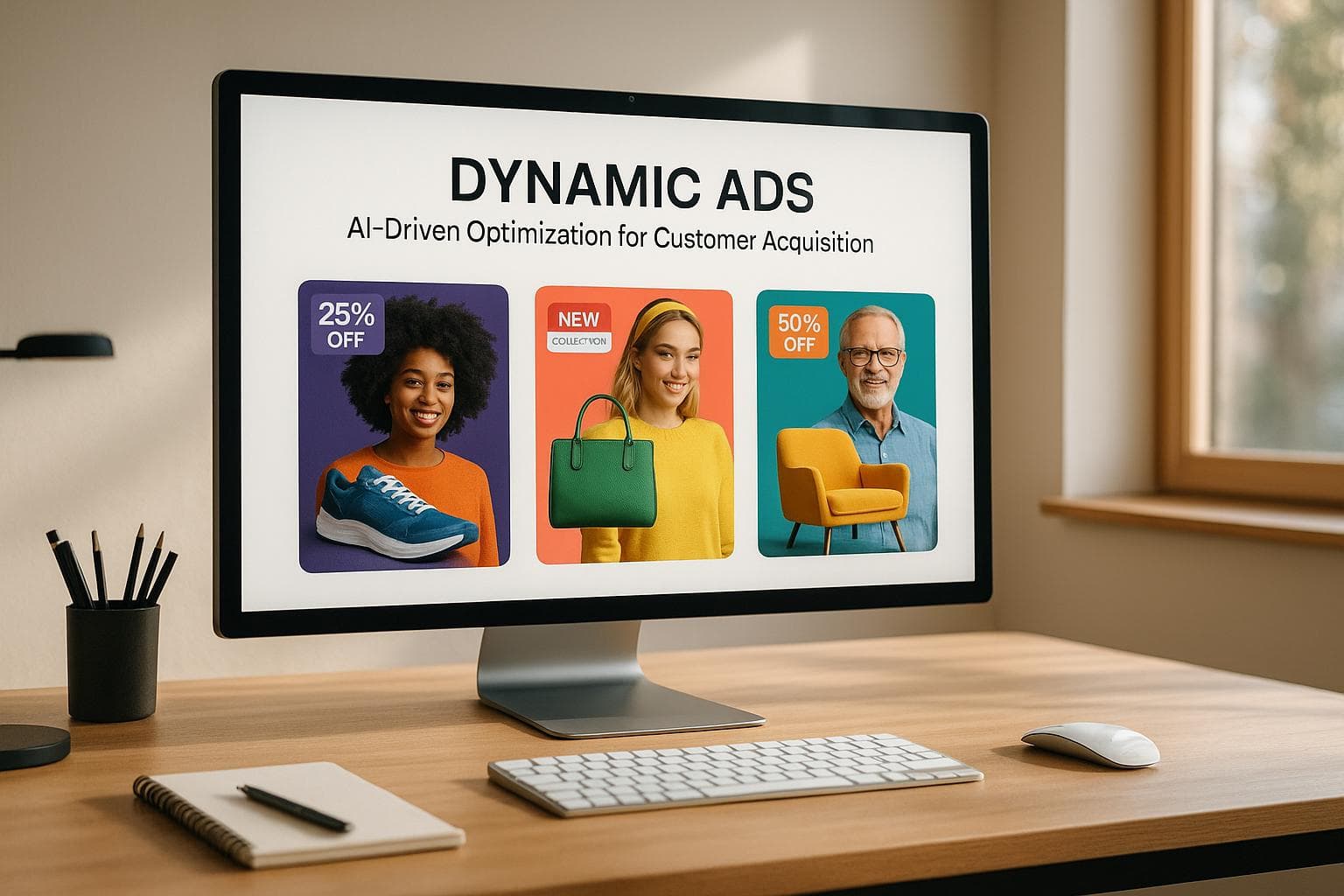How to Optimize Product Data for Better Ad Performance
Learn how to enhance product data for improved ad performance, leading to increased clicks, conversions, and ROI through actionable strategies.
Did you know poor product data can cost businesses $15 million annually? It’s true - bad data leads to fewer clicks, lower conversions, and wasted ad spend. But the good news? Optimizing your product data can turn things around.
Here’s what you need to know:
Why It Matters: Accurate, detailed product info boosts visibility, improves ROI, and builds customer trust.
Key Fixes:
Write keyword-rich, platform-specific product titles.
Use high-quality, mobile-friendly images without watermarks or borders.
Create clear, engaging product descriptions with essential details upfront.
Include correct product attributes like GTINs and MPNs for better targeting.
Tools to Help: AI-powered systems can automate updates, enrich data, and track performance in real-time.
Quick Wins:
Add relevant keywords to your product titles for an 18% boost in click-through rates.
Use clear, high-resolution images to improve engagement.
Regularly audit and update your product data to prevent errors and stay competitive.
Optimizing product data isn’t just about better ads - it’s about smarter, more profitable marketing.
Enhance your product feed with AI to save time & improve pMax & Shopping results (w/ ProductHero)
Writing Effective Product Titles
Product titles are more than just labels - they're the gateway to clicks and conversions. A well-crafted, keyword-rich title not only grabs attention but also reinforces the quality of your product data, which is crucial for running effective ads.
Keyword Selection and Placement
The placement of keywords in your title matters - a lot. Keywords positioned at the beginning of a title tend to perform better because Google's algorithm assigns more weight to them. According to a study by Search Engine Land, product titles packed with relevant keywords saw an 18% increase in click-through rates (CTR), and exact query matches drove CTRs up by as much as 88% [1].
Here’s a quick guide to structuring product titles across different industries:
| Industry | Title Structure | Example |
|---|---|---|
| Apparel | Brand + Gender + Product Type + Attributes | Adidas Women Running Shoes Black 39 |
| Electronics | Brand + Attributes + Product + Model + Color | Sony PlayStation 5 Disc Video Game Console (Ps5 Disc Console), Black |
| Health/Beauty | Brand + Ingredients + Product + Size | Bobbi Brown Vitamin Enriched Face Base - 1.7 oz. / 50 mL |
Platform Title Requirements
Each advertising platform has its own rules for product titles, so it's essential to tailor your approach accordingly. Make sure your titles include key product details like size, color, gender, and material. At the same time, avoid common pitfalls such as using multiple languages, excessive punctuation, special characters, email addresses, or website URLs.
Title Performance Testing
Testing is the cornerstone of improving product title performance. By tweaking one variable at a time and analyzing metrics like CTR and revenue, you can uncover what resonates most with your audience. For example, adding phrases like "Formulated By Doctors" boosted clicks by 74% and orders by 98%. Later, incorporating "Organic Ingredients" increased clicks by 104% and revenue by a staggering 152% [3].
To run effective tests:
Focus on clear, measurable success metrics.
Use tools like supplemental feeds or feed rules to make adjustments.
Track performance with Google Analytics link parameters [2].
Next, we’ll dive into image standards and how they work hand-in-hand with optimized titles to enhance ad performance.
Product Image Standards and Best Practices
High-quality product images are essential for meeting technical specifications and ensuring a professional presentation.
Image Technical Requirements
Each advertising platform has its own set of technical requirements to ensure your product images display correctly. Here's a breakdown of the key specifications:
| Requirement Type | Specification |
|---|---|
| Accepted Formats | JPEG (.jpg/.jpeg), WebP (.webp), PNG (.png), non-animated GIF (.gif), BMP (.bmp), TIFF (.tif/.tiff) |
| URL Protocol | Must begin with http/https |
| Image Quality | High-resolution originals only |
| Prohibited Elements | No watermarks, promotional text, or borders |
| AI-Generated Images | Include IPTC metadata for AI-generated content |
To ensure your images are properly indexed and displayed in shopping ads, configure your robots.txt file to allow both Googlebot and Googlebot-image to access image URLs. Additionally, maintaining consistency across variant images can help improve user experience.
Product Variant Image Guidelines
Using consistent images for product variants not only enhances your brand's professionalism but also helps build customer trust. Stick to these key practices:
Use the same lighting setup for all variant images.
Keep image angles consistent across different color or style options.
Ensure product details in the images match the landing page content exactly.
Apply clear and accurate color naming conventions in your listings.
"Images that grab the user's attention are likely to lead to more clicks and conversions." - Giovanni Miranda, Marketing Specialist, GoDataFeed [4]
Capturing additional variant images can also be useful for repurposing across various platforms. And don’t overlook the importance of optimizing images for mobile users.
Mobile Image Standards
With mobile shopping on the rise, optimizing images for smaller screens is critical. Pay attention to these key areas:
Visual Clarity
Keep images sharp and simple for small screens. Avoid overly busy or complex backgrounds that might take focus away from the product.
Platform-Specific Optimization
Consider how your images will appear on different advertising platforms. For instance, avoid using predominantly blue or white backgrounds on Facebook, as they may blend into the platform's native design [4].
Ad Format Compatibility
Ensure your images meet the specific requirements of different ad formats. Here’s a quick guide:
Ad Format Image Requirements Single Image High-resolution with a clear focal point Carousel Consistent aspect ratio across all images Collection A cover image plus coordinated product shots
Product Description and Data Quality
This section dives into creating engaging product descriptions and maintaining accurate data to improve ad performance.
Writing Product Descriptions
When crafting product descriptions, striking a balance between search optimization and user engagement is crucial. Here are some key elements to focus on:
| Element | Best Practice | Impact |
|---|---|---|
| Title Structure | Brand + Product Type + Key Features | Boosts search visibility |
| Character Usage | 150 characters or fewer | Ensures full display across platforms |
| Key Information | Front-load important details | Increases click-through rates |
| Language Style | Use natural flow with specific details | Keeps users engaged |
Pair these descriptions with well-structured product attributes to fine-tune ad targeting and performance.
Product Attribute Setup
Including accurate product attributes can significantly enhance the effectiveness of your ads. For instance, retailers who added correct GTINs experienced a 20% increase in clicks on average [5]. Here are the key attributes to focus on:
Product Identifiers
Ensure each product variant has unique identifiers, such as:GTIN (Global Trade Item Number)
MPN (Manufacturer Part Number)
Recognizable brand name
Technical Specifications
Provide detailed and precise specifications that align with your landing page, including:Size and dimensions
Material composition
Available colors
Technical features
Accurate and detailed attributes not only improve ad relevance but also build consumer trust.
Data Quality Management
Maintaining high-quality data is essential for sustained ad success. During the 2020 COVID-19 period, businesses that optimized their product feeds saw remarkable results [6]:
79% increase in impressions
109% increase in clicks
16.7% increase in conversion rates
To keep your data in top shape, follow these steps:
Regular Audits
Check and update prices
Verify stock availability
Validate landing page URLs
Ensure images meet platform standards
Automated Verification
Monitor feed synchronization
Stick to feed update schedules
Set up error alerts
Track performance metrics
Compliance Monitoring
Follow platform-specific character limits and attribute guidelines
Adhere to formatting rules and policy requirements
sbb-itb-0bd1697
AI-Powered Product Data Management
AI-driven systems analyze every product detail to enhance performance across shopping channels.
Feed Management Automation
Our automated feed management system ensures product data stays updated across multiple advertising platforms. Here's how it works:
| Element | Automated Updates | Impact |
|---|---|---|
| Pricing | Live price adjustments | Prevents pricing discrepancies |
| Inventory | Stock level updates | Reduces the risk of overselling |
| Promotions | Sale price updates | Keeps promotional offers accurate |
"AI systems now evaluate every product attribute and give preferential treatment to feeds with complete, accurate data. Those that fall short get buried." - Bryan Falla, Digital Marketer [7]
These automated updates form the backbone of AI-powered advancements in product data management.
AI Data Enrichment Tools
AI tools take product data to the next level by filling gaps and optimizing details. Key capabilities include:
Natural Language Processing (NLP): Detects and fills missing product attributes.
Smart Categorization: Automatically assigns products to the most suitable categories.
Title Optimization: Crafts search-friendly titles to improve visibility.
Tag Generation: Adds relevant tags based on user behavior and interests.
To make the most of these tools, ensure your base product data is clean, set up supplementary feeds for enrichment, and regularly monitor performance.
Performance Tracking Dashboard
Building on automated updates and AI-enriched data, our dashboard offers real-time insights to help retailers fine-tune their strategies. Here's how it supports better decision-making:
| Strategy | Application | Result |
|---|---|---|
| Premium Channel Allocation | Direct high-performing products to Google Shopping | Maximizes return on ad spend (ROAS) |
| Custom Label Creation | Adjust bids for seasonal bestsellers | Optimizes advertising budgets |
| Performance Monitoring | Track product-level metrics | Pinpoints areas for improvement |
The dashboard doesn’t just track performance - it highlights underperforming products and offers actionable recommendations. With real-time data analysis, retailers can quickly adapt their strategies to improve ad performance and drive better results.
Conclusion: Steps to Improve Ad Performance
Boosting ad performance hinges on the quality of your product data. As highlighted through strategies like optimizing titles, images, and feeds, small adjustments can lead to big results. Here's a quick breakdown of key areas to focus on:
| Optimization Area | Key Actions | Expected Impact |
|---|---|---|
| Title Structure | Highlight essential details upfront, use all 150 characters, and include product-specific nouns | Better search relevance and visibility |
| Data Quality | Automate updates, use GTINs/MPNs, and ensure consistency across platforms | Improved platform recognition |
| Image Standards | Upload high-resolution, mobile-friendly images | Increased visual appeal and engagement |
| Feed Management | Enable real-time updates for pricing and inventory, and tailor feeds for different channels | Fewer errors and higher ROAS |
To take your ad performance even further, consider these additional steps:
Write SEO-friendly titles that include essential product keywords.
Add detailed product specifications to descriptions for clarity.
Keep attribute mapping consistent across all advertising channels.
Use real-time analytics to refine and improve your data continuously.
FAQs
How can AI systems improve product data optimization for better ad performance?
AI can revolutionize how product data is optimized by diving deep into shopper behavior, search trends, and purchase patterns. This approach ensures your products resonate with potential buyers. By fine-tuning elements like product titles, descriptions, and attributes, AI aligns your listings with the algorithms used by specific platforms while catering to what customers are actively searching for. The result? Better visibility and higher engagement.
What’s more, AI facilitates dynamic updates to your product data, keeping it accurate and relevant at all times. It also supports channel-specific customization, allowing you to adapt product information for the unique demands of each advertising platform. This tailored approach not only boosts ad performance but also ensures your campaigns are more targeted, driving better results and maximizing your ROI.
What are the best practices for using keywords in product titles to boost click-through rates?
How to Boost Click-Through Rates with Better Product Titles
Creating product titles that grab attention and drive clicks isn't just about listing the basics - it's about being strategic with your keywords and formatting. Here's how to make your product titles work harder for you:
Add key attributes: Include specific details like color, size, or other features that make the product stand out. These small touches help your title stand apart in a crowded search result.
Use language your customers understand: Think about the terms your audience is likely typing into the search bar. Keyword research can help you pinpoint these phrases and weave them naturally into your titles.
Put the most important details up front: Search engines and shoppers alike tend to focus on the beginning of a title. Start with your most critical keywords or attributes to improve visibility.
Keep it the right length: Aim to maximize the character limit (up to 150 characters), but don’t sacrifice clarity. Typically, titles between 75–100 characters strike a good balance between being informative and easy to read.
Create unique titles for variants: If you’re selling different versions of the same product, such as various colors or sizes, make sure each variant has its own unique title. This helps improve exposure for multiple items in search results.
When you optimize product titles with these strategies, you're not just improving your search rankings - you’re making it easier for potential customers to find exactly what they’re looking for.
Why should you regularly review and update your product data, and how does it improve ad performance?
Keeping your product data fresh and accurate is crucial if you want your ads to connect with the right audience and deliver solid results. When your product details are up-to-date, your ads are more likely to show up for relevant searches, which means better visibility and more engagement.
Regular updates also ensure that things like prices, availability, and inventory levels are accurate. This prevents you from wasting money on ads for products that are out of stock or no longer available. Plus, staying on top of your data builds customer trust and keeps your ads aligned with the requirements of different platforms - helping you maximize your return on investment (ROI).
Yohann B.










